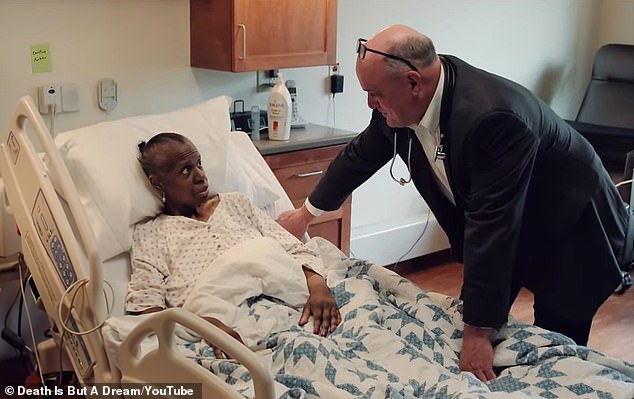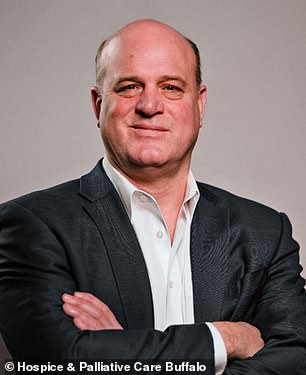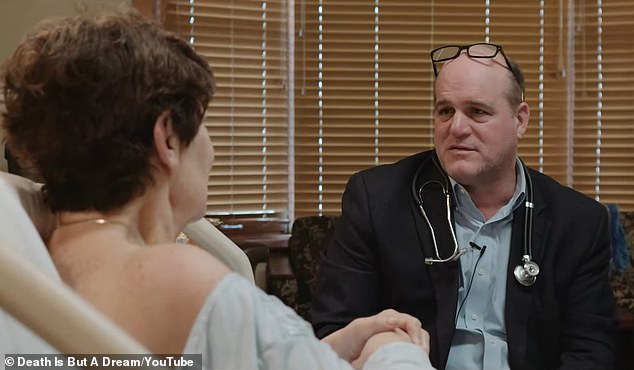When faced with death, what would be the first thing that comes to mind?
According to a doctor specializing in terminal illness, patients often have visions that help them be at peace with their life decisions, whether through a moving memory or a totally fantastical vision.
Palliative care physician Dr. Christopher Kerr of Buffalo, New York, has been studying end-of-life events for years.
He said patients often have dreams and visions that leave them with a feeling of “love, of being together again, of being reunited with their loved one.”
“It’s fascinating,” he said.
And children have very different experiences than adults, as they have less understanding of death, meaning they often find solace through their imagination.
Patients often have dreams and visions that leave them with a feeling of “love, of being back together, of being reunited with their loved one,” said Dr. Christopher Kerr, a palliative care physician.

The overall theme is that patients come to peace with the decisions they have made in their lives, Dr. Kerr found.
For people with a colorful past who might have committed crimes in their life, they seem to have visions linked to the people they affected.
Speaking on the podcast Next level soulDr Kerr said: ‘We had a man in his 40s who had spent most of his life in prison. He had a drug addiction and had had neck cancer.
“He was dreaming, he was joking, he was very jovial… and then he starts crying because he’s having these horrible dreams. [that] he’s being stabbed by all the people he’s hurt… and he collapses.’

Palliative care physician Dr. Christopher Kerr of Buffalo, New York, has been studying end-of-life events for years.
“But then when he recovered, he asked to see a daughter to whom he wanted to express his love and apologize,” Dr. Kerr said.
“And after that he died peacefully.”
In Dr. Kerr’s opinion, patients “don’t deny bad and painful things [that] they sweat, but they approach them and use them in a way that is very interesting.’
The research team at Hospice & Palliative Care Buffalo, where Dr. Kerr works, has published multiple studies on this topic and documented more than 1,500 end-of-life events, many of which are recorded on video.
He talked about another patient who had been involved in the Normandy invasion as a teenager. He had been suffering from PTSD his entire life and never received help.
“He came to our unit at the end of his life… he was having such horrible experiences where he was seeing body parts and bloody water and screaming and he couldn’t rest.”
Patients have to be relaxed and accept their situation, to some extent, in order to die, Dr. Kerr said.
You can’t actually die unless you can sleep. It’s pretty hard to do, because you just pass by while you’re sleeping,” he explained.
But one day, the patient managed to get some sleep and Dr. Kerr asked him what he had dreamed.
“He says, ‘I had a big dream, where I relived the best day of my life,’ which was the day he received his discharge papers.”
“And I had a really good dream, presumably in Normandy, and a soldier I didn’t know came up to him and said, ‘No, we’re going to go find you.’
After that, the man slept peacefully and died in his sleep, Dr. Kerr said.
“So the feeling that he had abandoned people had come full circle,” the doctor added.
The overall theme is that patients come to peace with the decisions they have made in their lives.
It is at the end of life that you can see what Dr. Kerr called “post-traumatic growth,” where positive elements of previous difficulties come to light.
Children have a different experience at the end of life, Dr. Kerr said, as they may not have a concept of finality or mortality.
They may also not have met anyone who has died as a point of reference or someone they can imagine meeting in some form of future life.
Dr. Kerr said children often see animals that convey the message “that they are loved and not alone.”
“Children are creative and imaginative and can tap into that part of themselves,” she said.
A little girl imagined an entire scene around her while she was in her hospital bed.
“She created a castle for herself… there was a swimming pool, the animals were returned, there’s a piano, there was a window with warm light coming in,” Dr Kerr said.
‘When I asked, “What does the castle represent?” She said, “A safe place.”

